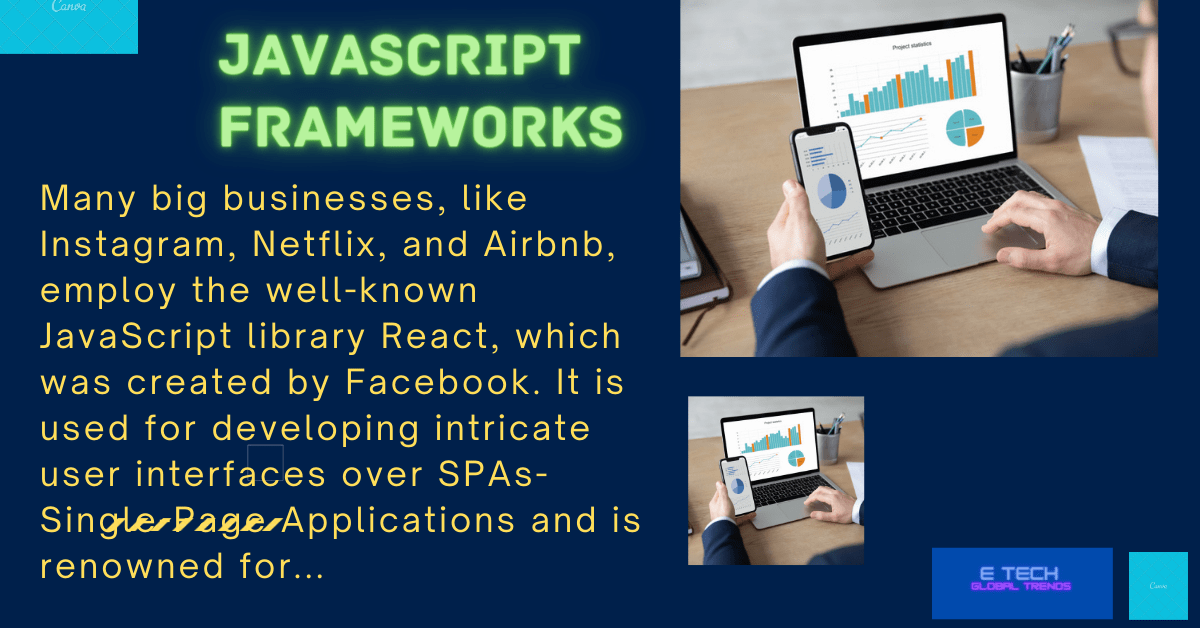JavaScript Frameworks
Today we are going to have a comparative study on JavaScript Frameworks. Recently there is a huge trend in this technology. Web developers are searching for new easy handling methods. Are you among them? So, this presentation is just for you. this will be great informative content.
Shall we dive deeper?
The trendy programming language JavaScript serves to create interactive online applications. The availability of several JavaScript frameworks makes it simpler to construct complicated apps rapidly and effectively.
What components should we consider before starting?
your particular demands and tastes will determine which framework is ideal for you.
So, we advise beginning using React or Vue.js if you are unsure about which framework to use.
Frameworks provide a fair blend of capabilities and simplicity, and they are well-liked and supported.
1.0 The project’s scope and complexity
A complicated framework like Angular may not be necessary if you are developing a small project. However, you might want a framework that can offer additional structure and help if you are developing a large or sophisticated project.
2.0 The particular features you require
Some frameworks are more appropriate for particular project types than others.
For instance, if you need to create a mobile application with several animations, Consider using a framework such as React Native.
3.0 Experience of your team fellows
You might be able to employ a more complicated framework like Angular if your team has experience with JavaScript frameworks.
You might want to start with a more straightforward framework such as React Native if your team is unfamiliar with JavaScript frameworks.
Let’s discuss some trendy options…
Before that, let us explain an important element of SPA.
What is the concept of SPA?
SPA stands for Single Page Application. a single web page website or web application.
it doesn’t require the user to reload the page while using it. Traditional multi-page web apps need full page reloads whenever you move between parts or take other actions since the browser must request and load brand-new pages from the server.
SPAs, on the other hand, only load…
- the basic HTML,
- CSS, &
- JavaScript files
when users engage with the application, the content is dynamically updated.
Single Page Applications’ essential traits include:
1. Fast Content Loading
AJAX which stands for Asynchronous JavaScript and XML or modern techniques like Fetch API are using SPAs to retrieve data from the server in the background.
After that, without requiring a complete page refresh, this data serves to update whatever is for the page. As a result, SPAs may provide a user experience that is slicker and more responsive.
2. Distinction of Interests
SPAs encourage a more distinct division between the application’s front end and back end. The front end displays and manages the user experience, whereas the backend primarily acts as a data source.
3. Client-Side Rendering
CSR- when rendering content, JavaScript frameworks such as React, Angular, or Vue.js works on the client side.
The SPA handles rendering the data into the page, and often the server supplies data through APIs (commonly in JSON format).
4.0 Routing
Client-side routing is often managed by SPAs. As users go between the application’s various areas, the URL modifies.
However, the SPA reads the URL & loads the appropriate content instead of making fresh requests to the server for new pages.
5. Enhancing Performance
After the first page load, SPAs can minimize data transmission and perhaps speed up load times by caching resources and optimizing data retrieval.
6. Smooth User Experience
Users enjoy quicker transitions between various parts or activities when utilizing SPAs since they refresh content without requiring a full page reload, much as when using a desktop program.
7. Offline Assistance
When there is a weak or unreliable internet connection, SPAs can make use of service workers to provide offline access and offer an additional robust user experience.
However, It’s crucial to remember that SPAs do have certain drawbacks.
Because crawlers for search engines can have trouble understanding dynamically loaded material.
they aren’t always as SEO-friendly as conventional websites.
Additionally, because the full JavaScript framework and components have to download, initial load times may take longer.
To a certain extent, these problems can mitigate with careful optimization & lazy-loading approaches.
Due to their seamless and engaging user experience, SPAs have generally grown in popularity and are still a key trend in contemporary web development.
9 best trending JavaScript Frameworks
1.0 React
Many big businesses, like Instagram, Netflix, and Airbnb, employ the JavaScript library React, which was created by Facebook. It is for developing intricate user interfaces over SPAs- Single-Page Applications.
- its speed,
- scalability, and
- adaptability.
With its component-based design, React makes it simple to reuse code and updates the UI effectively using a virtual DOM.
2.0 AngularJS
Google created the JavaScript framework AngularJS, which is frequently using to create dynamic web apps. An open-source framework for web applications, Angular is built on TypeScript.
It is utilized to create desktop, mobile, and single-page applications.
Purchase of it is possible.
includes features including;
- dependency injection,
- two-way data binding, and
- directives for building reusable components.
An application development framework with all the features required,
such as routing, data management, & testing tools, is called AngularJS.
3.0 Node.js
A well-liked JavaScript runtime environment for creating server-side applications is Node.js.
It is effective and scalable due to the event-driven, non-blocking I/O mechanism it utilizes.
4.0 D3.js
A well-known JavaScript library for data visualization is called D3.js. With the use of HTML, CSS, and SVG, it offers a collection of APIs for building intricate, dynamic visualizations.
In 2011, Mike Bostock created D3.js, which presently maintains a developer community.
It is frequently utilized by programmers and businesses worldwide, such as IBM, The New York Times, as well as Airbnb.
5.0 Express.js
Popular Node.js web application framework Express.js is used. Developers can design straightforward, scalable, and quick Apps.
Because of their basic approach to creating web applications and APIs.
TJ Holowaychuk created Express.js in 2010, and the Node.js Foundation currently looks after it.
6.0 Knockout.js
7.0 Riot.js
8.0 Svelte
9.0 Vue.js
You will find these last 3 descriptions down below…
Why do we suggest ReactJs Framework?
The React framework is among the most well-liked ones for JavaScript.
Facebook created the popular framework React for creating user interfaces.
Its effectiveness, component-based design, and capacity to produce dynamic and interactive online applications have all contributed to its substantial rise in popularity.
React makes use of a fictitious DOM, which stands for-Document Object Model to quickly update & render components, improving speed and user experience.
Additionally, it offers a robust ecosystem of tools, libraries, and community support, which makes it simpler for developers to create sophisticated applications.
Angular, created by Google, is another renowned JavaScript framework. Large-scale application development is made simple with the help of the comprehensive framework Angular. It offers functions like dependency injection, two-way data binding, and a strong templating mechanism.
9. Vue.js
Another prominent JavaScript framework that has grown in recognition recently is vue.js. It provides a methodical method for creating user interfaces and enables developers to gradually incorporate its features following project specifications.
For its simplicity, adaptability, and simplicity of integration into current projects, Vue.js is well-known.
It’s crucial to remember that as new frameworks develop and technology advances, the recognition of JavaScript frameworks may fluctuate over time.
Thus, it is always advised to keep up with the most recent trends and select a framework under the needs of the project, the support of the community, and personal preferences.
What are the prospects for JavaScript frameworks like VueJS and ReactJS?
What are the trends?
Wide frameworks like React, Angular, and Vue have a thriving ecosystem and a very wide user base.
Even if framework development ceased tomorrow. this would still be true for the following five or more years, and frameworks would not disappear.
Additionally, they are being “jQueried” at the same time. Due to its extensive functionality that was not there with JavaScript or web APIs, jQuery was essential to front-end development in the late 2000s.
However, web standards are developing quickly, and the range of what they can accomplish in comparison to what frameworks can or should accomplish is likewise evolving.
For instance, for performance, it is becoming less and less tenable to assert certain frameworks.
All 3 frameworks;
use the idea of a “shadow DOM” to perform rendering tasks reportedly more effectively than the browser. The shadow DOM is being abandoned by more recent frameworks like;
- Svelte,
- Qwik, and
- Solid.
React, Angular, & Vue were all developed on the premise that executing certain JavaScript-based code on a web server may be advantageous while also assuming that it was generally a good idea to handle a lot of functionality in JavaScript on the client. rendering using a hybrid.
We’ve seen models emerge in the last few years that allow content to create quickly on the server, without necessarily being in javascript, and they allow us to provide pages that don’t necessarily require javascript to load and view them.
Therefore, the paradigms that served as the basis for React/Angular/Vue are changing. some of the best front-end thinkers developed these frameworks.
So, they will continue to be useful for many years to come and tackle the proper challenges.
Another relatively recent change is the increased focus being placed on the value offered by hosts and the middleware layer. Players like Vercel of Netlify are driving this.
What is the most straightforward framework for creating single-page apps?
Some developers claim that Vue and Reat are a bit complex.
Of course, no need to cry.
you can try another option.
create SPAs -Single-Page Apps using a variety of JavaScript frameworks without having to deal with the intricacy of Vue and React.
Knockout.js
The use of the Knockout.js framework is one possibility. You can easily design rich, interactive SPAs with the aid of Knockout, a lightweight framework that implements the MVVM.
it stands for Model-View-View Model paradigm.
If you’re searching for a lightweight structure that is straightforward to work with, it is a fantastic option because it is reasonably quick to understand and use.
Riot.js
Riot.js is an alternative. Riot is a lightweight micro-library.
It offers a straightforward, reactive paradigm for displaying and updating the user interface (UI) of your application as well as the ability to construct custom tags to represent that UI.
Svelte
Finally, you can think about utilizing the Svelte framework. With the help of the compiler Svelte, your components are converted into browser-compatible, effective JavaScript code.
It can be quicker and simpler to use than additional frameworks since it does not employ a virtual DOM.
The ideal option for you will ultimately rely on your unique demands and preferences. To determine which choice suits you the most, it could be useful to experiment with a few different ones.
Well, when you insist some important points have to keep in mind. Because nothing is perfect. And every option is relatively good and bad, both.
Advantages of using JavaScript frameworks
Include
- Productivity and Efficiency; JavaScript frameworks offer pre-made templates, libraries, and components that make development easier and faster. They provide a methodical and orderly way to create web applications, minimizing the amount of original code. that is a must.
- Reliability and consistency: Frameworks uphold coding best practices and standards, simplifying codebase upkeep and updating. They offer a standard design and framework, which makes it simpler for different developers to work together on a project.
- Cross-BrowserCompatibility;
JavaScri pt frameworks take care of browser compatibility concerns, making sure that your online application functions uniformly in all major browsers and mobile platforms.
- consists of UI Components; UI widgets and components are frequently pre-built in frameworks, making it easier for developers to construct aesthetically beautiful and dynamic user interfaces.
- Community support; Large and vibrant communities exist for popular JavaScript frameworks. thus there are a ton of resources, documentation, & community assistance are there. When requesting assistance or solving problems, this might be useful.
Disadvantages of JS frameworks
Nevertheless, there are certain drawbacks also.
1.0 Difficult to learn
A JavaScript framework may need some time and work to learn and master. The ideas, APIs, and conventions of the framework must be thoroughly understood by developers.
2.0 Performance Costs
The speed of the online application may affect the additional costs and dependencies that certain JavaScript frameworks may bring.
To get greater speed, it’s critical to use a framework that is both lightweight and optimized.
3.0 Limitations over Flexibility
Because of their proprietary conventions and patterns, JavaScript frameworks may be less flexible and offer fewer modification choices.
Custom needs might not always complement the framework’s architecture.
4.0 dependency over other management
When using a JavaScript framework, dependencies, and external libraries are frequently required. It might be difficult to manage these dependencies while maintaining them currently.
Before choosing to employ a JavaScript framework, it’s crucial to take them into account and assess the unique requirements of your project.
Hope this content helps
Cheers!
Read more on related topics here; how to Become a full-stack developer, front end developer







